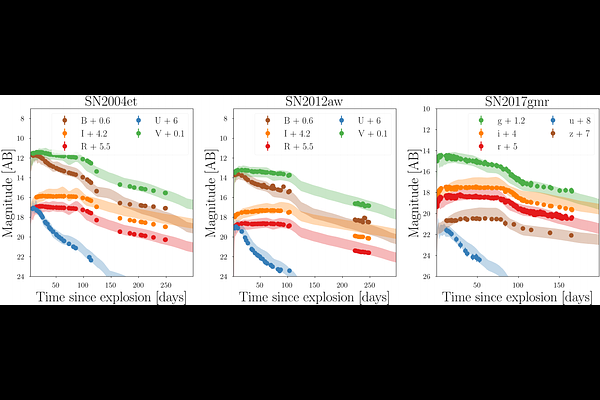Surrogate models for lightcurves and photosphere properties of Type II supernovae

Surrogate models for lightcurves and photosphere properties of Type II supernovae
Nikhil Sarin, Takashi J. Moriya, Avinash Singh, Anjasha Gangopadhyay, K-Ryan Hinds, Steve Schulze, Conor M. B. Omand, Kaustav K. Das
AbstractInferences on the properties Type II supernovae (SNe) can provide significant insights into the lives and deaths of the astrophysical population of massive stars and potentially provide measurements of luminosity distance, independent of the distance ladder. Here, we introduce surrogate models for the photospheric properties and lightcurves of Type II SNe trained on a large grid of simulations from the radiation hydrodynamics code, {\sc stella}. The trained model can accurately and efficiently ($\sim 30$ms) predict the lightcurves and properties of Type II SNe within a large parameter space of progenitor ($10-18 M_{\odot}$ at ZAMS) and nickel masses ($0.001-0.3M_{\odot}$), progenitor mass-loss rate ($10^{-5}-10^{-1}~M_{\odot}$yr$^{-1}$), CSM radius ($1-10\times10^{14}$cm), and SN explosion energies ($0.5-5 \times 10^{51}$erg). We validate this model through inference on lightcurves and photosphere properties drawn directly from the original {\sc stella} simulations not included in training. In particular, for a synthetic Type II SNe observed within the 10-year LSST survey, we find we can measure the progenitor and nickel masses with $\approx 9\%$ and $\approx 25\%$ precision, respectively, when fitting the photometric data while accounting for the uncertainty in the surrogate model itself. Meanwhile, from real observations of SN~2004et, SN~2012aw, and SN~2017gmr we infer a progenitor ZAMS mass of $12.15_{-1.06}^{+1.03} M_{\odot}$, $10.61_{-0.32}^{+0.37} M_{\odot}$, $10.4 \pm 0.3 M_{\odot}$, respectively. We discuss systematic uncertainties from our surrogate modelling approach and likelihood approaches to account for these uncertainties. We further discuss future extensions to the model to enable stronger constraints on properties of Type II SNe and their progenitors, for cosmological applications, and applications of our surrogate modelling approach to other transients.